Medieval helmets
During the middle ages, a lot of different types of helmets were made, all offering another level of protection and were worn during battles and warfare.
Medieval Helmets are made out of iron and steel, just like the rest of the Armour. In the middle ages, they were made by an armorer, which is a blacksmith who specialized in making quality Armour. Sometimes the Helmets were made by regular blacksmiths, which was cheaper but lesser in quality.
At times symbols were painted or crests were added on the Helmets for identification purposes.
In the early middle ages open-faced Helmets, like the spangenhelm, were the most common. These helmets didn't protect the facial area all that well. They sometimes had nasal protection. In the late middle ages, the face was completely protected with helmets like the great helm, the armet, and the bascinet, at least for knights and higher class men. The head was and still is one of the most important areas of the body to protect, as wounds on the head and skull are harder to fix.
When you’re choosing a helmet you have to compare the advantages and disadvantages, it’s a choice you have to make. Sometimes it’s better to have a completely protected face but other times it’s more useful to pick a lighter helmet in which you can have more movement. For infantry, it’s usually a better choice to pick the lighter helmet, whereas a knight or horsemen better pick full protection.
If you’re letting an armorer make a helmet specifically for you, you have to know what time period you are portraying. And no, ‘between 1300 and 1400’ is not specific enough. The maker of helmets needs a more specific period to make a helmet that is as authentic as possible. It is also best to know your location. For example, Italian Helmets can be very different from German helmets. And what type of person you are portraying.
The men usually wore a mail coif and padding underneath the helmet.
A mail coif is a hood made of chain mail, as extra protection for the neck and head. The mail coif is usually sewed to a fabric padding. The padding only covers the head, not the neck. It could be worn underneath a helmet or even without the helmet at all. This was common gear for the lower classmen. Most soldiers wore close-fitting coif, where the only open parts were the nose and the eyes. A coif does not always have mail attached to it, the word ‘coif’ can also relate to the padding alone. To some types of helmets, like the bascinet, you could attach an aventail, a chain mail neck, and shoulder protector. You could also wear a padded coif underneath your helmet, without the chain mail, for extra comfort and protection to bruises and chafing. It can also be used to help the helmet fit better. These paddings could cover the head or both head and neck.
The spangenhelms and nasal or Norman Helmets were in use in the early parts of the middle ages, later came the bascinet without visor. Visors became increasingly popular after 1180. Visors had holes to see through and holes to breathe.
Beneath you will find several types of medieval helmets in the order of their evolution.
*This post may contain affiliate links. I receive a small amount of compensation when you purchase from my links at no additional cost to you.
Kettle helm
Most popular in the 11th century
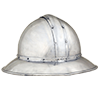 The kettle helmet was also called Eisenhut and chapeau de fer, meaning 'a hat of iron'. Its name came from its looks, just like a cooking pot, kettle or cauldron. These Helmets always had a wide brim and were open-faced and were sometimes worn with a coif underneath. This was a common helmet during the whole middle ages and mostly worn by infantry because it gave good protection to blows that came from above, like from horsemen and it held the sun out of the wearers' face. These Helmets were not only used during the war but also for other tasks, like mining, where the brim helped protect against falling stones and sand. In earlier times, these Helmets were made of multiple steel plates, like the spangenhelms. Around the 13th century, they started to make the kettle hat out of one piece of steel.
The kettle helmet was also called Eisenhut and chapeau de fer, meaning 'a hat of iron'. Its name came from its looks, just like a cooking pot, kettle or cauldron. These Helmets always had a wide brim and were open-faced and were sometimes worn with a coif underneath. This was a common helmet during the whole middle ages and mostly worn by infantry because it gave good protection to blows that came from above, like from horsemen and it held the sun out of the wearers' face. These Helmets were not only used during the war but also for other tasks, like mining, where the brim helped protect against falling stones and sand. In earlier times, these Helmets were made of multiple steel plates, like the spangenhelms. Around the 13th century, they started to make the kettle hat out of one piece of steel.
Advantages
- Protection to blows from above
- Sun out of the face
- Cheap
Disadvantages
- No facial protection
Spangenhelm
Early middle ages to 10th century
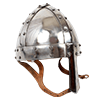 This Helmets' name comes from the frame, which was made of strips. ‘spangen’ is the German word for these strips. These strips connected 4-6 metal plates. Most of the time the spangenhelms had a broad nasal strip to protect the nose, which is the center of the face, and where conical of shape. You could do a lot with them in terms of decoration, like adding an aventail or a mask.
This Helmets' name comes from the frame, which was made of strips. ‘spangen’ is the German word for these strips. These strips connected 4-6 metal plates. Most of the time the spangenhelms had a broad nasal strip to protect the nose, which is the center of the face, and where conical of shape. You could do a lot with them in terms of decoration, like adding an aventail or a mask.
The earliest spangenhelms had leather or metal cheek guards. The later ones, the ones that were used in the middle ages, didn’t have these guards anymore. Soldiers could also attach an aventail to the helmet.
This was a widely used type of helmet because it was so easy to make and therefore very cheap to produce.
Advantages
- Good sight and breathing
- Easy to make
- Cheap
Disadvantages
- Not very strong
- No full facial protection
Great helm
13th - 16th century
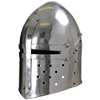 Great helmets, also known as great helm, pot helm, heaume or bucket helm, is the most-known type of helmet. At first, these Helmets had a square top, but this happened to become a target for hammers. Later the designs upgraded to a conical (pointy) top, this lessened the impact of hammers and swords.
Great helmets, also known as great helm, pot helm, heaume or bucket helm, is the most-known type of helmet. At first, these Helmets had a square top, but this happened to become a target for hammers. Later the designs upgraded to a conical (pointy) top, this lessened the impact of hammers and swords.
It was one of the first helmets that entirely protected the face. The Great Helm also had small openings for eyes and perforations for the mouth.
At later times the helmet was developed with protection around the neck, eventually, the entire helmet rested on the shoulders of the knight. (14th century)
To keep the helmet secured in the head there was a leather chinstrap.
The knights didn't just wear these things on their heads. Underneath they wore extra protection made out of cloth and fiber padding. This made the great helms very warm.
These Helmets were sometimes painted colors, matching the knight's shield. They were sometimes adorned with crests, perforations for breathing, and decorated visors. When they were decorated with crests, it was mostly used for ceremonial purposes or for identification. If you don't know what a crest is, it’s a piece of decoration that you could place on top of your great helm, like horns, wings or skulls.
These helmets were mostly worn by knights during the times of the crusades, in the late middle ages.
Advantages
- Full facial protection
- Very few and small openings: protection against piercing
Disadvantages
- Heavy (weight: between 1.5kg and 3kg)
- Hard to see and breathe
- Hard to communicate due to the small openings
Bascinet and hounskull
14-15th century
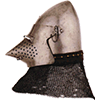 The bascinet, also called bassinet, was usually an open-faced helmet but it sometimes also used with a conical visor. This had the look of a beak or a snout, that’s why it was called a hounskull, which is medieval for ‘dog-faced’. Today it is also sometimes called ‘pig-faced’. It was used by both knights and infantry, making it a very popular helmet.
The bascinet, also called bassinet, was usually an open-faced helmet but it sometimes also used with a conical visor. This had the look of a beak or a snout, that’s why it was called a hounskull, which is medieval for ‘dog-faced’. Today it is also sometimes called ‘pig-faced’. It was used by both knights and infantry, making it a very popular helmet.
There were two ways a visor could be attached to the helmet. The klappvisor had one hinge on the frontal top part of the bascinet. And the side-pivot with on each side of the head one hinge.
One could also attach an aventail to the bascinet with leather straps. An aventail is chainmail to cover the neck and shoulders, be aware that this is not the same as a chainmail coif.
In the 14th century, The bascinet took the place of the great helm in popularity. At first, the bascinet was worn underneath the great helmet. But soldiers often removed the great helmet so they could move a bit easier and had less weight to carry.
Infantrymen had to be very mobile, see more and shouldn't get to warm, therefore bascinets were not the right choice for them. They were better off with lighter open-faced helmets, like the kettle helm.
After around 1440 this helmet became out of use, the noblemen and knights also started to prefer open-faced Helmets (like the bascinet but without the visor) because of the weight of visored Helmets became a burden.
At the end of the 15th century, these helmets evolved from the conical shapes to more rounded shapes and thus transitioning into the armet.
Advantages
- Lighter than the great helm
- Design helps deflect weapons
Disadvantages
- Sight and breathing
- Still too heavy
Armet
16th century
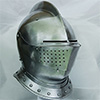 The first experimenting for a helmet that more resembled the form of the human head started in Italy.
The first experimenting for a helmet that more resembled the form of the human head started in Italy.
This helmet fitted closely around the head and was broader on the top and narrower around the neck. Because you cannot slide it over the head, it was necessary to have a mechanism to open and close the helmet easily.
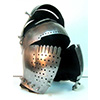 these helmets usually consist of four parts. The helmet itself is a bowl with a tail on the back of the neck, two cheek plates and the visor, which could be moved upward. Usually, the top of the visor is the lower part of the opening for the eyes, the helmet bowl itself is the upper part of the opening for the eyes.
these helmets usually consist of four parts. The helmet itself is a bowl with a tail on the back of the neck, two cheek plates and the visor, which could be moved upward. Usually, the top of the visor is the lower part of the opening for the eyes, the helmet bowl itself is the upper part of the opening for the eyes.
You could add extra plates as protection for your neck, this is called a wrapper plate. This was useful for cavalry (you know, the horsemen) to not get struck by lances or anything that comes from beneath in the neck area.
If you’re looking to buy an armet, you should know that this is one of the more expensive medieval/Renaissance helmets since it has more separate parts and is harder to make.
Advantages
- Compact and light
- Complete protection of the head
Disadvantages
- Sight
